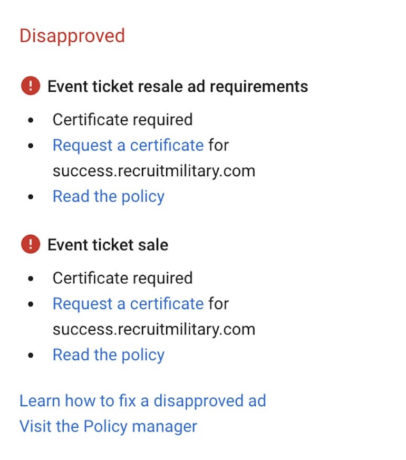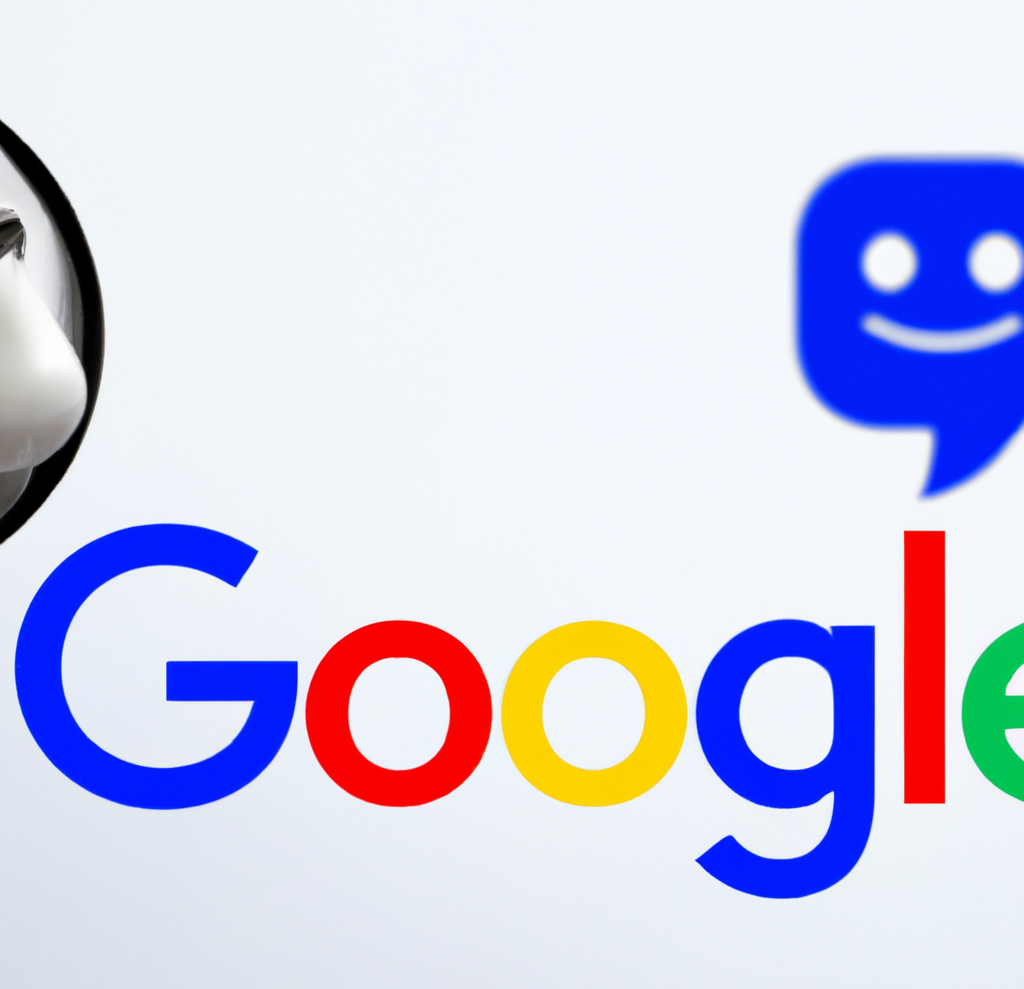Google Policy Ad Disapprovals: A Story of False Flags

Having your ads disapproved for whatever reason can be a big roadblock for account success. These disapprovals lead to a loss of time when you have to research the policy that was violated, retool your ad to either meet the requirements or avoid the policy altogether, then submit the ads for review again. In this loss of time, these ads cannot serve to your audiences which leads to dips in performance. Now, think about this same scenario except your ads do not infringe upon any policy and still get disapproved anyway. This was the bane of my existence for months on one of my larger accounts. Having to check policy reviews daily and follow the allotted processes took time away from developing strategy and moving more important initiatives forward.
The Approval Process
First, we need to understand how and why our ads are being disapproved for policy infringement. The most important thing an account manager can do from the beginning is to understand any policy related to their business. Review any Google advertising policy that could be related to the scope of your work and make sure that your ads follow the policy. A list of Google’s advertising policies can be found here.

Next, we need to understand the system that flags our ads. All enabled ads within an account go through a complex review process via Google’s algorithms and a program called Swiffer. This process is supposedly 99% accurate, but when there are roughly 160 billion searches per month in Google alone (Statista) then the number of ads that fall through the cracks is still pretty astronomical. If your ads receive 200 disapprovals in 30 days, then that account is moved onto a Swiffer list for manual review and MAYBE gains the mythical policy exclusion. This exclusion is only for the lucky, so for the rest of us what do we do next?
Email Notifications
The first step is recognizing that your ads are being disapproved for whatever reason. You can edit your email notifications in each account to trigger when a number of events happen within an account. Specifically, for this case, you can set up your notifications to trigger when your ads are disapproved. So rather than needing to check in the account daily, your email can be the first line of defense in managing this issue. To edit your notification settings:
- Navigate to the wrench icon in the upper right corner of the interface
- Select setup
- Select preferences
- Navigate to notifications (1 of 2 options within the preferences page)
- Turn on “Disapproved ads and policy alerts

Submit a Ticket
This is my go-to move if the disapprovals do not seem like a regular occurrence. The ticket submittal process is actually quite easy and does not take too much time when in a one-off scenario. The kicker is that Google will look into the ad within a 24-hour period after receiving the ticket. Perfectly reasonable from their end in my opinion, but this means our ads could be off for roughly 36 hours or more if I received my email notification overnight and submitted my ticket first thing in the morning. To submit a ticket, navigate to this link.
Then, you will have to fill out a decently quick form explaining the issue. Fields include:
- Contact information
- Google Ads Customer ID (and Child Account ID if applicable)
- Language
- Topic or Policy
- Summary of the issue
- Phone Number (new)
- Submit a supporting attachment (new)
Calling In
Using the same info as above, you can always call the Google support number and give them the above info. The review process takes the same amount of time but there are a few benefits to calling in. First, if you have multiple campaigns and ads affected, then by calling in you can have the support take down more of the information upfront for a 1 stop process. In this same scenario, this would require a few ticket submissions. Second, if you are speaking with a Google support member, they may be able to inform you or connect you with someone who can describe how you are infringing upon the policy and how to avoid it.
Google Support Phone Number: 1-866-2-GOOGLE (866-246-6453)
Submitting a Bug
This is a more elusive process that few know about and is only accessible if you have a dedicated account rep. with Google or can get through to Google’s policy team. In my case, accounts dedicated agency rep. helped uncover this process. I never received too much information on where and how this bug was submitted into the Google system, but it did permanently stop my ads from being flagged for a policy that they were not infringing upon. Basically, you submit the below info to your contact:
- Issue Type (Policy in Question/Reason for Disapproval)
- Issue Description (must include formats affected, URL of the site affected, screenshots, and dates)
- Customer ID
- Campaign/Ad Group IDs (Cannot say “All” or “Multiple” – please be specific)
- Creative IDs (At Least one example of a creative impacted by this disapproval)
Once they have this information and have the policy team submit the bug, then it will take 24-72 hours to push through the system, review all of the affected ads, and reverse their designation pending any other policies that you were unaware of. It is also important to note that any new ads created after the bug can still be disapproved, but once they are the ads will be review again and likely reversed with no action needed from yourself.
Conclusion
Ad disapprovals are not the most complicated thing to deal with in our search accounts but they are a nuisance and can waste time if not dealt with properly. By taking the steps provided above, we advertisers can mitigate how much time, effort, and headspace we use when dealing with policy disapprovals. Thanks for reading and please check out this awesome PPC Hero Google Shopping disapproved ads post from last week.
AI
Exploring the Evolution of Language Translation: A Comparative Analysis of AI Chatbots and Google Translate

According to an article on PCMag, while Google Translate makes translating sentences into over 100 languages easy, regular users acknowledge that there’s still room for improvement.
In theory, large language models (LLMs) such as ChatGPT are expected to bring about a new era in language translation. These models consume vast amounts of text-based training data and real-time feedback from users worldwide, enabling them to quickly learn to generate coherent, human-like sentences in a wide range of languages.
However, despite the anticipation that ChatGPT would revolutionize translation, previous experiences have shown that such expectations are often inaccurate, posing challenges for translation accuracy. To put these claims to the test, PCMag conducted a blind test, asking fluent speakers of eight non-English languages to evaluate the translation results from various AI services.
The test compared ChatGPT (both the free and paid versions) to Google Translate, as well as to other competing chatbots such as Microsoft Copilot and Google Gemini. The evaluation involved comparing the translation quality for two test paragraphs across different languages, including Polish, French, Korean, Spanish, Arabic, Tagalog, and Amharic.
In the first test conducted in June 2023, participants consistently favored AI chatbots over Google Translate. ChatGPT, Google Bard (now Gemini), and Microsoft Bing outperformed Google Translate, with ChatGPT receiving the highest praise. ChatGPT demonstrated superior performance in converting colloquialisms, while Google Translate often provided literal translations that lacked cultural nuance.
For instance, ChatGPT accurately translated colloquial expressions like “blow off steam,” whereas Google Translate produced more literal translations that failed to resonate across cultures. Participants appreciated ChatGPT’s ability to maintain consistent levels of formality and its consideration of gender options in translations.
The success of AI chatbots like ChatGPT can be attributed to reinforcement learning with human feedback (RLHF), which allows these models to learn from human preferences and produce culturally appropriate translations, particularly for non-native speakers. However, it’s essential to note that while AI chatbots outperformed Google Translate, they still had limitations and occasional inaccuracies.
In a subsequent test, PCMag evaluated different versions of ChatGPT, including the free and paid versions, as well as language-specific AI agents from OpenAI’s GPTStore. The paid version of ChatGPT, known as ChatGPT Plus, consistently delivered the best translations across various languages. However, Google Translate also showed improvement, performing surprisingly well compared to previous tests.
Overall, while ChatGPT Plus emerged as the preferred choice for translation, Google Translate demonstrated notable improvement, challenging the notion that AI chatbots are always superior to traditional translation tools.
Source: https://www.pcmag.com/articles/google-translate-vs-chatgpt-which-is-the-best-language-translator
Google Implements Stricter Guidelines for Mass Email Senders to Gmail Users

Beginning in April, Gmail senders bombarding users with unwanted mass emails will encounter a surge in message rejections unless they comply with the freshly minted Gmail email sender protocols, Google cautions.
Fresh Guidelines for Dispatching Mass Emails to Gmail Inboxes In an elucidative piece featured on Forbes, it was highlighted that novel regulations are being ushered in to shield Gmail users from the deluge of unsolicited mass emails. Initially, there were reports surfacing about certain marketers receiving error notifications pertaining to messages dispatched to Gmail accounts. Nonetheless, a Google representative clarified that these specific errors, denoted as 550-5.7.56, weren’t novel but rather stemmed from existing authentication prerequisites.
Moreover, Google has verified that commencing from April, they will initiate “the rejection of a portion of non-compliant email traffic, progressively escalating the rejection rate over time.” Google elaborates that, for instance, if 75% of the traffic adheres to the new email sender authentication criteria, then a portion of the remaining non-conforming 25% will face rejection. The exact proportion remains undisclosed. Google does assert that the implementation of the new regulations will be executed in a “step-by-step fashion.”
This cautious and methodical strategy seems to have already kicked off, with transient errors affecting a “fraction of their non-compliant email traffic” coming into play this month. Additionally, Google stipulates that bulk senders will be granted until June 1 to integrate “one-click unsubscribe” in all commercial or promotional correspondence.
Exclusively Personal Gmail Accounts Subject to Rejection These alterations exclusively affect bulk emails dispatched to personal Gmail accounts. Entities sending out mass emails, specifically those transmitting a minimum of 5,000 messages daily to Gmail accounts, will be mandated to authenticate outgoing emails and “refrain from dispatching unsolicited emails.” The 5,000 message threshold is tabulated based on emails transmitted from the same principal domain, irrespective of the employment of subdomains. Once the threshold is met, the domain is categorized as a permanent bulk sender.
These guidelines do not extend to communications directed at Google Workspace accounts, although all senders, including those utilizing Google Workspace, are required to adhere to the updated criteria.
Augmented Security and Enhanced Oversight for Gmail Users A Google spokesperson emphasized that these requisites are being rolled out to “fortify sender-side security and augment user control over inbox contents even further.” For the recipient, this translates to heightened trust in the authenticity of the email sender, thus mitigating the risk of falling prey to phishing attempts, a tactic frequently exploited by malevolent entities capitalizing on authentication vulnerabilities. “If anything,” the spokesperson concludes, “meeting these stipulations should facilitate senders in reaching their intended recipients more efficiently, with reduced risks of spoofing and hijacking by malicious actors.”
Google’s Next-Gen AI Chatbot, Gemini, Faces Delays: What to Expect When It Finally Launches

In an unexpected turn of events, Google has chosen to postpone the much-anticipated debut of its revolutionary generative AI model, Gemini. Initially poised to make waves this week, the unveiling has now been rescheduled for early next year, specifically in January.
Gemini is set to redefine the landscape of conversational AI, representing Google’s most potent endeavor in this domain to date. Positioned as a multimodal AI chatbot, Gemini boasts the capability to process diverse data types. This includes a unique proficiency in comprehending and generating text, images, and various content formats, even going so far as to create an entire website based on a combination of sketches and written descriptions.
Originally, Google had planned an elaborate series of launch events spanning California, New York, and Washington. Regrettably, these events have been canceled due to concerns about Gemini’s responsiveness to non-English prompts. According to anonymous sources cited by The Information, Google’s Chief Executive, Sundar Pichai, personally decided to postpone the launch, acknowledging the importance of global support as a key feature of Gemini’s capabilities.
Gemini is expected to surpass the renowned ChatGPT, powered by OpenAI’s GPT-4 model, and preliminary private tests have shown promising results. Fueled by significantly enhanced computing power, Gemini has outperformed GPT-4, particularly in FLOPS (Floating Point Operations Per Second), owing to its access to a multitude of high-end AI accelerators through the Google Cloud platform.
SemiAnalysis, a research firm affiliated with Substack Inc., expressed in an August blog post that Gemini appears poised to “blow OpenAI’s model out of the water.” The extensive compute power at Google’s disposal has evidently contributed to Gemini’s superior performance.
Google’s Vice President and Manager of Bard and Google Assistant, Sissie Hsiao, offered insights into Gemini’s capabilities, citing examples like generating novel images in response to specific requests, such as illustrating the steps to ice a three-layer cake.
While Google’s current generative AI offering, Bard, has showcased noteworthy accomplishments, it has struggled to achieve the same level of consumer awareness as ChatGPT. Gemini, with its unparalleled capabilities, is expected to be a game-changer, demonstrating impressive multimodal functionalities never seen before.
During the initial announcement at Google’s I/O developer conference in May, the company emphasized Gemini’s multimodal prowess and its developer-friendly nature. An application programming interface (API) is under development, allowing developers to seamlessly integrate Gemini into third-party applications.
As the world awaits the delayed unveiling of Gemini, the stakes are high, with Google aiming to revolutionize the AI landscape and solidify its position as a leader in generative artificial intelligence. The postponed launch only adds to the anticipation surrounding Gemini’s eventual debut in the coming year.
-

 PPC7 days ago
PPC7 days agoHow 6 SEO Experts Are Navigating Google Update Chaos
-

 SEARCHENGINES7 days ago
SEARCHENGINES7 days agoBing Search Testing Removing Cache Link From Search Results
-

 MARKETING6 days ago
MARKETING6 days ago60 Remote Work Stats to Know in 2024
-

 WORDPRESS5 days ago
WORDPRESS5 days ago10 WordPress Influencers to Follow in 2024 – WordPress.com News
-

 WORDPRESS6 days ago
WORDPRESS6 days ago8 Best WordPress Migration Services (Compared)
-

 PPC5 days ago
PPC5 days agoCompetitor Monitoring: 7 ways to keep watch on the competition
-

 MARKETING6 days ago
MARKETING6 days agoFeeling Stuck: What to Do When You Don’t Know What to Do
-

 SEARCHENGINES5 days ago
SEARCHENGINES5 days agoMore Google March 2024 Core Update Ranking Volatility









